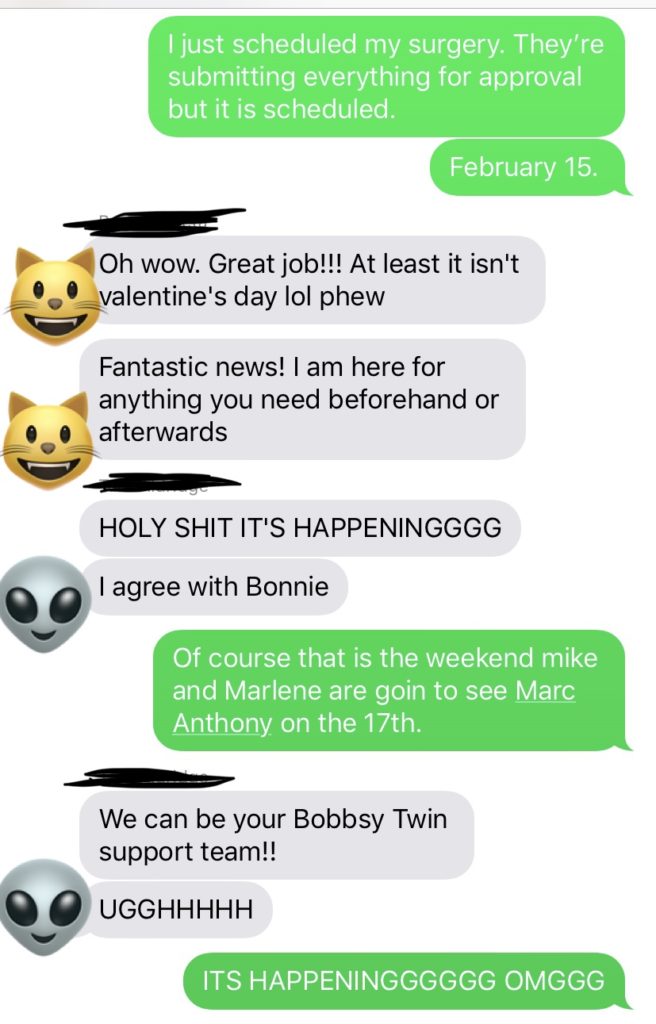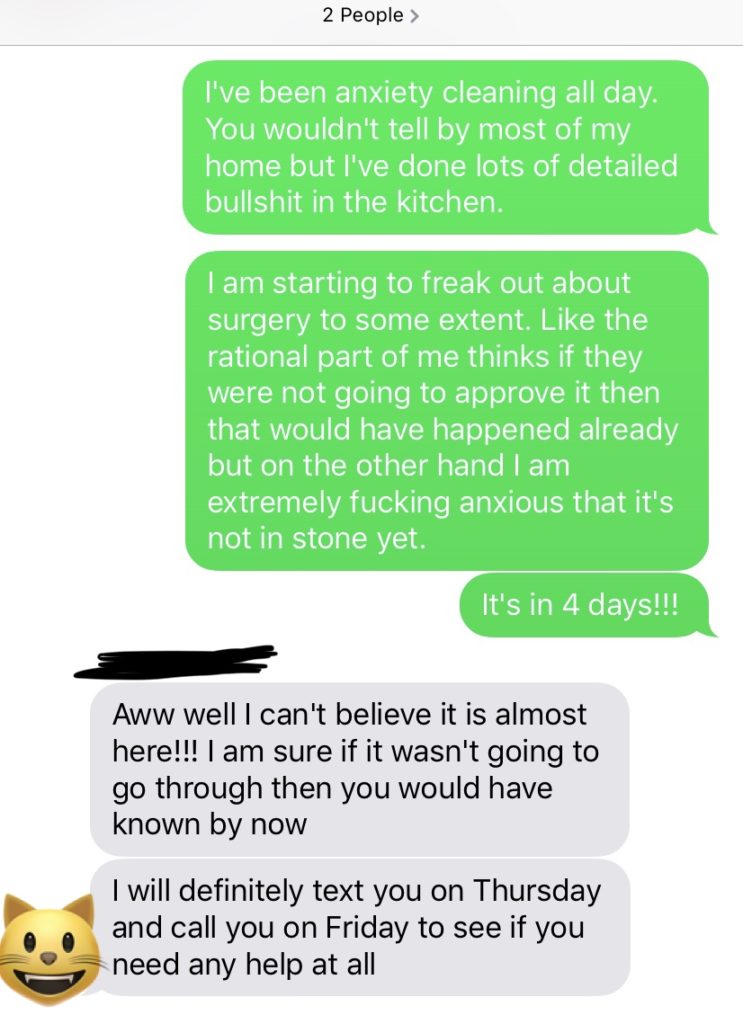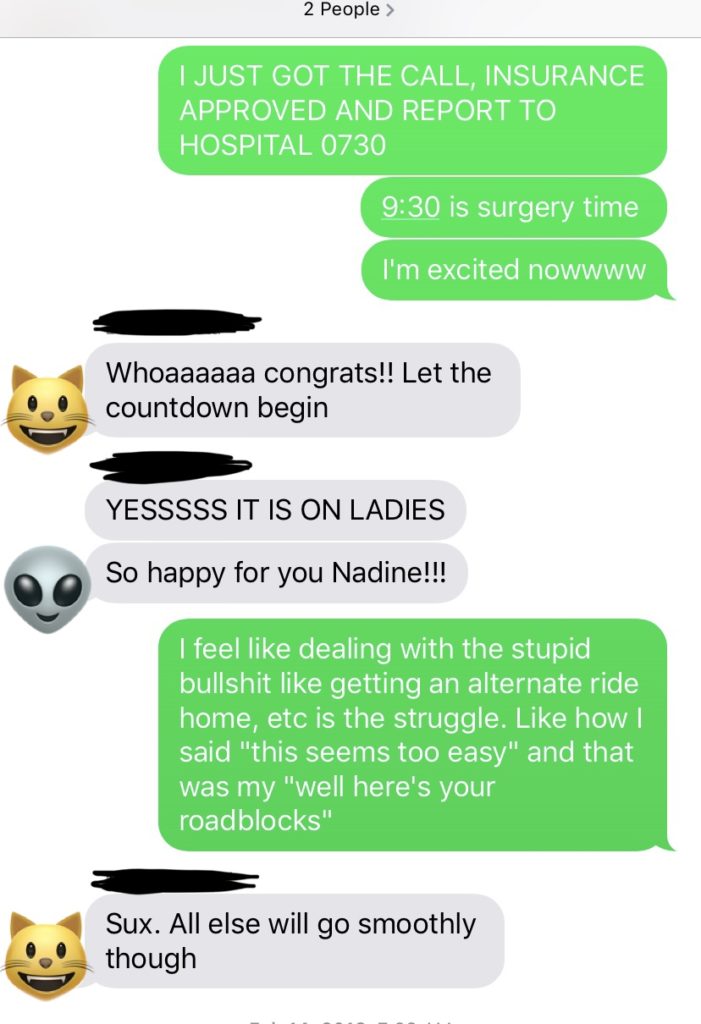In my last post, I had touched on the fact that I got weight loss surgery, and some of the emotions surrounding the decision to do it. Now, I’m going to dive into the process, the work, and what it’s been like to lose 100 pounds.
The process started for me on January 17th, 2018. That was the night that I attended my medical practice’s seminar about Weight Loss Surgery. It was an information session with my surgeon who put on a presentation for about 2 hours discussing the two types of surgery he offered, different insurance questions, and the changes you should expect to make in the immediate future surrounding the choice to get surgery. The two types of surgery offered were Vertical Sleeve Gastrectomy and Roux-en-Y Gastric Bypass. To be honest, I still don’t fully understand how your guts get rerouted with the bypass, even though this is the surgery my boyfriend ended up getting in September. Vertical Sleeve Gastrectomy, VSG or just The Sleeve, is called that because what it essentially is, you have a big portion of your stomach organ cut out from your body, leaving you with just a small stomach pouch that looks like a sleeve. It ends up being about the size of a banana. This surgery is done laproscopically, which means it is minimally-invasive, uses several small incisions instead of opening you up all the way and having all your insides on display. A minimally-invasive surgery with small incisions has the benefits of easier recovery, less pain and less scarring. Surgery is done under general anesthesia, takes 60-90 minutes and has a typical stay of one overnight in the hospital.

I left the seminar that evening with a lot of information and a lot to think about. If I’d get surgery, which one? The sleeve featured less complications possibly than the bypass, though bypass boasted a higher rate of excess weight loss in the first year. The bypass was also ideal for aleviating obesity-related medical conditions quickly, like diabetes and acid reflux. Since I didn’t have any pressing medical issues, I thought the sleeve would be the best option for me. On my way out of the seminar, I had asked the doctor what the next step would be, and he said to just make an appointment with him – that he actually had an opening the next day, due to some cancellations in his schedule. It was January, peak cold and flu season, so it made sense. The next morning, I made sure to call first thing so I could snag that appointment before anyone else at the seminar did.
The appointment was fairly routine. I was weighed and had my vitals taken like at any physical. Then we sat and talked about my health history, my history with weight loss, and my goals. We discussed the two surgery types, and though I had an idea which one would be best for me, I asked his professional opinion on which he’d recommend and he agreed that my choice of the sleeve was the best option. Once comfortable with the thought of “I’m really going to do this,” I asked him “well, what goes into this, logistically speaking?” Would I have to do a pre-operative diet, weight loss plan, subsequent visits and follow-ups? Everyone’s insurance requirements will be different, and I was pleasantly surprised by the prerequisites for my insurance carrier. To get approved for surgery I needed to do the following:
- Have a BMI over 35% (or if it was lower, a person would need to have an additional weight-related medical issue to qualify)
- Meet with the nutritionist twice within 30 days (or meet just once, if you have documentation you’ve tried an additional weight loss program in the past year – which I had, by providing my Weight Watchers information)
- Have my Primary Care Physician write a note that they support and endorse this option.
- Get cleared as mentally fit for this surgery by a psychologist.
So at my initial appointment with my surgeon, based on my insurance, there was no requirement for an arbitrary time-based waiting period prior to getting surgery approval. There was no pre-surgery dieting program I needed to do. That’s why on the spot, he scheduled my surgery that day. Reserved my surgery date on the books for February 15, 2018. It felt like a whirlwind as though things were happening very quickly, but in a good way. I was ready. He booked my surgery and sent me on my next steps: I met with the nutritionist that same day right after him. The only next step to check off before they can send my file off to insurance for approval was the psychologist visit, which I called and scheduled for a few days later.
I wasn’t sure what to expect at the psychologist visit, and at this point, I wasn’t involved in any online or in-person support groups. This part made me nervous, and I wondered what sort of mental readiness they were looking for. I mean, I’d recently lost my mother and wasn’t dealing with that. I just compartmentalized it and moved on so I could live my life without grief. It wasn’t the healthiest option of “well I’ll have to deal with THAT at some point,” the equivalent of slappin’ a strip of Flex Seal on that part of my brain. Basically, the appointment was making sure I understood the procedure I was getting, that I knew what changes I’d have to make, that I had a support system, that I knew the work I’d still have to put in. There was an assessment to see if you had eating disorders, and they asked about your general mental health, depression, anxiety, coping mechanisms. It was also explained to me that some people exhibit “transfer addictions” once their coping mechanism of over-eating isn’t available. Meaning, some people who had WLS (weight loss surgery) might turn to vices like alcohol or shopping. I disclosed that I’d had depression previously and addressed that with therapy, that I had situational anxiety when dealing with my divorce, and that I don’t see alcohol being a problem for me – I could take it or leave it. I had a firm grasp on what the surgery entailed and I was ready to take on the challenge of changing my life for the better this time, once and for all. We talked about my grief, how I’d tried a bereavement group and it wasn’t for me and I quit after the first session. Then, at the end of the appointment, she added in “oh yeah and I have to ask this, it’s required, are you considering hurting yourself or anyone else” and I laughed and said no, god no, of course not. I mean I’d never murder anyone, we all want to, I’d never do it, though I watch enough murder shows I could get away with it I bet…. I mean no, definitely no, I wish to strike all this from the record. It was awkward, and I really had to be like “I’m normal enough I swear.”
I must have convinced her of my mental readiness because she submitted to the surgeon that I passed my psych eval. Now with all my boxes checked off, my request for approval was sent off to my insurance carrier. All I had to do was wait. There was no reason to believe that it wouldn’t be approved, but I was nervous. “This seems too easy” was the prevailing idea. Or they wouldn’t approve my prior Weight Watchers receipt/attendance for some reason.

The final set of pre-surgery things I needed to do were routine physical tests. They took some blood and I had an EKG to determine my heart was healthy. Some people, depending on their risk factors for sleep apnea, also need to undergo a sleep study. But as an obese-yet-bafflingly-healthy person, I didn’t need that either.

At the seminar and the appointment with my surgeon, he stressed that the most successful patients attend the monthly support group meeting, prior to surgery and after. The thought of this made me kind of uncomfortable, but I put that aside and “got comfortable with being uncomfortable” and made my way to my first support group meeting on February 5, 2018. Even though my insurance approval hadn’t come through yet and I was getting more and more nervous by the day, I decided I’d go to the meeting. If this is what successful patients do, I want to be one of them, so I will do the thing. It was a diverse group of men and women of all races, varying adult ages, all at different steps in their weight loss journey. Some were pre-op like me, others had just had surgery recently, and some were long-term, several years out of surgery and at their goal weight. What struck me, is the people who were at goal, looking at them, you’d never know. They just looked like “normal” people. I don’t know if other overweight people feel this way, but it’s like there’s two types of folks – fat people and normal people. Normal people who don’t have to think about every meal, every snack, every calorie burned or consumed. Who don’t have to think twice about if a store will carry their size, if they will fit into an airplane seat, if they should even try fitting on a ride at the boardwalk. People who just live and don’t have to feel like a prisoner to their body. I wanted to be A Normal Body Person like these people. They talked about their struggles, their victories, new recipes they’ve tried, different vitamins they’re taking, and a pharmaceutical rep came in and talked about their mail-order bariatric vitamin services and gave out some information about it. I got a good feeling being there, but mostly kept to myself and observed and didn’t really speak.
Days ticked by and my insurance approval still hadn’t been received. I’d been calling the doctor’s office asking for updates often enough, and while they assured me this is typical of that insurance company, there was still the nagging thought that I was going to be denied. But on February 11, just four days before my surgery, I received my approval letter that was dated February 5th. The surgeon’s office called and let me know my surgery would be at 9:30 am and to report to the hospital at 7:30 am to start checking in. No food after midnight like a gremlin, just “eat light” the day prior.
I was so relieved, and now the nerves set in. I didn’t allow myself to get nervous about surgery before now, because I was half-convinced it wasn’t going to happen. And there’s no sense in worrying about something I can’t control. I did the same tactic before getting a c-section too; I didn’t worry about the idea it could be POSSIBLE to get a c-section, even when the OB said that I was getting one while I was in the hospital, I didn’t worry until the point I was in the operating room getting my epidural/spinal block put in. It’s like I just condense all my worry into one brief panic attack instead of letting it take up a lot of mental space. You can bet the psychologist didn’t ask me about that.
Now all the pre-work and approval was done, stay tuned for Part Two where I talk about actually getting the surgery and the beginning of the work to come…
Check out the gallery below to see how my (redacted) group chat was lit with supportive vibes re: cut my gut





One “before” shot of me on a girl’s night out 

2 Responses to “Keeping it 100 (part one)”
Keeping it 100 (part two) – Night Caffeine
[…] You can read part one here which describes the relatively-short road to getting approved for weight … […]
Keeping It 100 (part three) – Night Caffeine
[…] Read Part 1: The Road to Surgery here […]